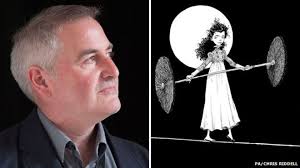Okay I apologise wholeheartedly for the 'reflection' image. I am often literal in my art but I don't apologise for that. This module has really helped me to understand who I am and where I am going on my journey.
I began this module as a serious student - I have always worked hard, researched thoroughly, been open to criticism, advice and new ideas whilst holding true to my influences and style. However, I have emerged at the end of the module with a different and, I hope, better viewpoint of the artist that I am and will continue to become.
I have always known that it is a brave move to change career, but I have learned that the skills I have already developed with carry on with me - the teamwork, planning, financial and budgeting, respect of deadlines, professionalism, understanding of process, negotiation, understanding of legislation etc that are crucial for Project Management are equally important when running a business in the creative industry.
I started writing the blogs in slightly different manner, my early posts are lighthearted and reflective of my past, the titles are fun and mainly related to music, one of my creative inspirations. The later posts are more serious in consideration of subject matter and future and the titles reflective of content.
After careful consideration, I have negotiated against parts of the module that are not right for me right now, specifically the CV creation and approaching agencies for internships and jobs, and have focused on my own studio and how I am going to use it for the next few years.
I have gained 'hands on' experience working with Bexie Bush and running a children's workshop, I have created promotional items, I have approached professionals in my field and been successful in securing interviews with several of them. Some of these contacts are now people I know I can contact going forward.
I have worked with my cohort to look at our individual paths, examine what is similar and what is different, I have been impressed with the commitment I have seen and wish every one of them well - I am sure they will not need my good wishes, I have seen a tremendous work ethic and the emergence of talents in many directions.
I have identified areas of strength in my practice, and also areas for improvement and new skills I need to learn and have made plans for the Summer on how I can acquire these skills in time for the all important third year of my studies.
I have considered and experimented with social media and learned lessons in what to post - and what not to post.
I have learned that there are myriad ways to make a living doing something I love, that I will not always be producing work that I love but that I am privileged to have the choice in what I do.
I have learned about the support that is available to me in the University, especially Debbie and her team, whose support is available to me for three years post studies and I am hugely grateful that this support will be available to me when I do need it.
And I've made a list of things 'to do' over the Summer. Here it is:-
• Complete some online tutorials for Adobe Illustrator
• Complete some online tutorials for Adobe InDesign
• Set up the Silhouette cutter ready for use with vector files (see learning point 1 above)
• Practice using the Wacom Cintiq
• Attend life drawing and print making Summer classes
• Enter three competitions to be set by the University (optional Summer projects)
• Enter Illustration Friday topic of the week
• Enter the Scrawlrbox challenge monthly
• Revise 'Lexi Dexter and the Summer of Surprises (working title)' and produce images ready for submission to publisher
• Have fun, rest and relax ready for the hard work in September
 |
| Lexi deserves some better illustrations |
My final thoughts on the module is that it has been a challenging, enjoyable, scary, fulfilling journey and that it has actually changed the way I think and work.
What a ride!
H. x

















































